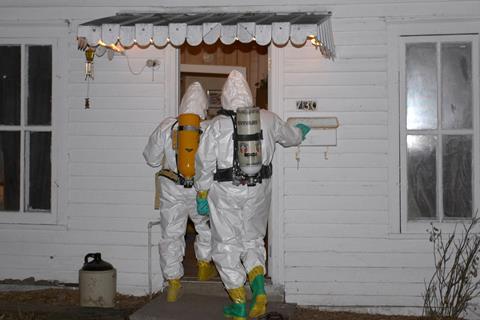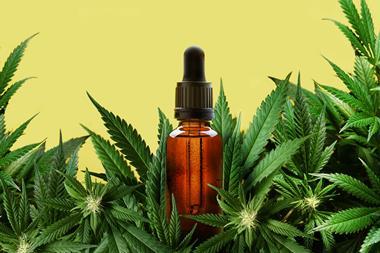Closing a meth lab is just the first step towards making it safe

With a variety of simple recipes widely available, featuring equipment and materials relatively easily obtainable, methamphetamine can be manufactured nearly anywhere. Clandestine laboratories range from rivalling legitimate drug production facilities in terms of size and sophistication to smaller ‘kitchen labs’ or ‘cooks’, with production done at a dizzying array of locations including private dwellings, hotels or motels, Airbnb properties and vehicles.1,2
When a clandestine laboratory is seized or production stopped, a variety of challenges remain – including whether a location can be adequately decontaminated. Sites used for smoking methamphetamine may also retain residues, though at far lower levels than detected at production sites.1 Rendering such sites safe is often a community priority.
Cleaning up contaminated sites often starts with examining how dirty they are. The extent of contamination depends on several factors including, but not limited to, exposure levels, surface composition and environmental conditions. For clandestine laboratories, the production method used onsite also impacts surface methamphetamine concentrations.
Most readily available recipes can be classified as one of three production methods – phenyl-2-propanone (P2P), red phosphorus (Red-P) or Birch reductions.3 All of these methods produce aerosols of methamphetamine and other reaction species that settle on surfaces, not to mention reaction solvents, solutions and waste that may spill or spread during production.
Pivotal ‘controlled cooks’ research from John Martyny and colleagues in 2007 found methamphetamine concentrations range from 0.1–860μg per 100cm2 for Red-P production and 0.1–160μg per 100cm2 for Birch reduction on surfaces less than two metres from larger-scale cooks.4 The researchers also examined 89 wipe samples from fourteen suspected clandestine laboratories, determining the mean and median methamphetamine concentrations as 511 and 28μg per sample respectively.
Much needed insight on smaller scale methamphetamine production was provided by Austin Ciesielski and colleagues in 2021, when they examined the most popular methamphetamine production route in the US – the ‘one-pot’ method.2 This method features a modified Birch reduction and is often used to yield small batches of methamphetamine for personal use. Ciesielski and colleagues selected a one-pot recipe routinely encountered in seized clandestine laboratories and used materials mostly purchased from retail stores – including 32oz Gatorade bottles as the single reaction vessel. Their clandestine laboratory was a plastic garden shed, sampled inside and out pre- and post-cook plus after decontamination with water. Quick in-field screening was done using methamphetamine specific lateral flow immunoassay (LFIA) kits, while a fluorescent covalent microbead immunosorbent assay (FCMIA) was used for laboratory quantitation. Methamphetamine levels were below those resulting from larger scale cooks, with surface concentrations within the shed ranging from <1.00–264.35ng per 100cm2 post-cook.
All samples taken from the one-pot site after water decontamination were below the lowest methamphetamine remediation concentration required by a US state (50ng per 100cm2).1 However, the researchers pointed out the site surfaces cleaned were chiefly composed of nonporous high-density polyethylene (HDPE). Far more absorbent surfaces like carpet, dry wall and wood present different decontamination challenges. Even on HDPE surfaces, areas where organic solvent had been spilled were an exception to the water only clean-up. More robust decontamination techniques are needed. A potentially promising one features a green chemistry catalyst with an impressive track record.
Multi-purpose cleaner
Detoxifying chemical and biological warfare agents, removing bisphenol A (BPA) from wastewater, breaking down synthetic oestrogenin wastewater – the list of cleaning jobs tackled by hydrogen peroxide–iron tetra-amido macrocyclic ligand complex (H2 O2/Fe-TAML) catalyst systems continues to grow. Recently published work by researchers from the University of Auckland, New Zealand, explores the use of a H2 O2/Fe-TAML system for methamphetamine decontamination.5
The reaction products resulting from interactions between clean-up agents and methamphetamine production compounds must be investigated robustly. Towards this end, the researchers carefully studied small-scale model reactions featuring either methamphetamine or the popular precursor ephedrine exposed to a H2 O2/Fe-TAML solution, using gas chromatography–mass spectrometry to identify the major and minor reaction products and pathways.
The major reaction products of methamphetamine oxidation by H2 O2/Fe-TAML were P2P and phenylacetone N-methylimine, both of which are also precursors used in illicit manufacturing. Benzaldehyde was the major reaction product of ephedrine oxidation, with this naturally occurring compound perhaps better known as a popular flavour and fragrance additive. On the clean-up front, H2 O2/Fe-TAML oxidised 88±2% of methamphetamine and 83±2% of ephedrine within five minutes. A second intermediary dose of H2 O2 saw those percentages increase to greater than 96% after one hour.
Methamphetamine decontamination via H2 O2/Fe-TAML is at the proof-of-concept stage, but these initial results show promise in helping communities rehabilitate sites of possible danger to areas of safer engagement once more.
References
1 E J Kuhn et al, Int. J. Environ. Res. Public Health, 2019, 16, 4676 (DOI: 10.3390/ijerph16234676)
2 A Ciesielski et al, J. Chem. Health Saf., 2021, 28, 49 (DOI: 10.1021/acs.chas.0c00078)
3 C V Owens et al, J. Chem. Health Saf., 2017, 24, 23 (DOI: 10.1016/j.jchas.2017.01.004)
4 J W Martyny et al, J. Chem. Health Saf., 2007, 14, 40 (DOI: 10.1016/j.jchas.2007.01.012)
5 A Mayer et al, Forensic Chem., 2023, 34, 100490 (DOI: 10.1016/j.forc.2023.100490)

















No comments yet